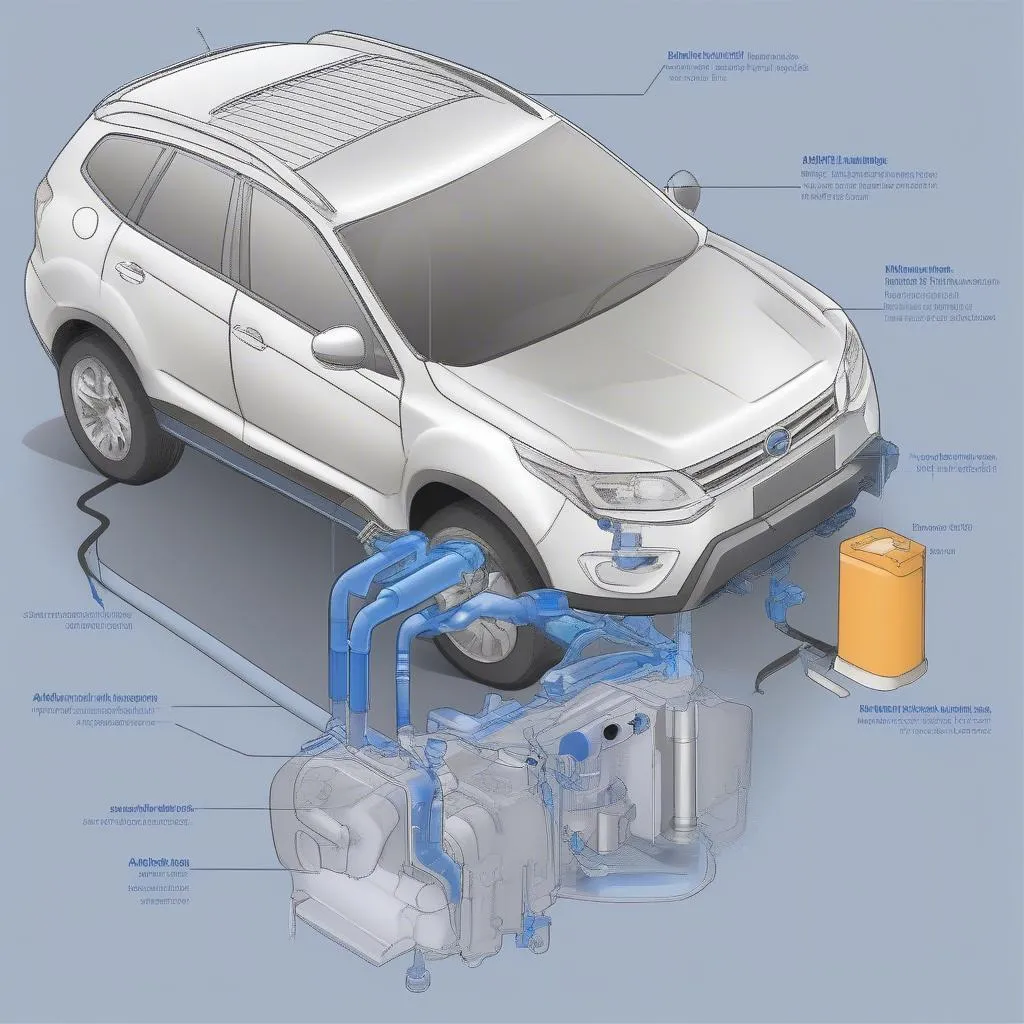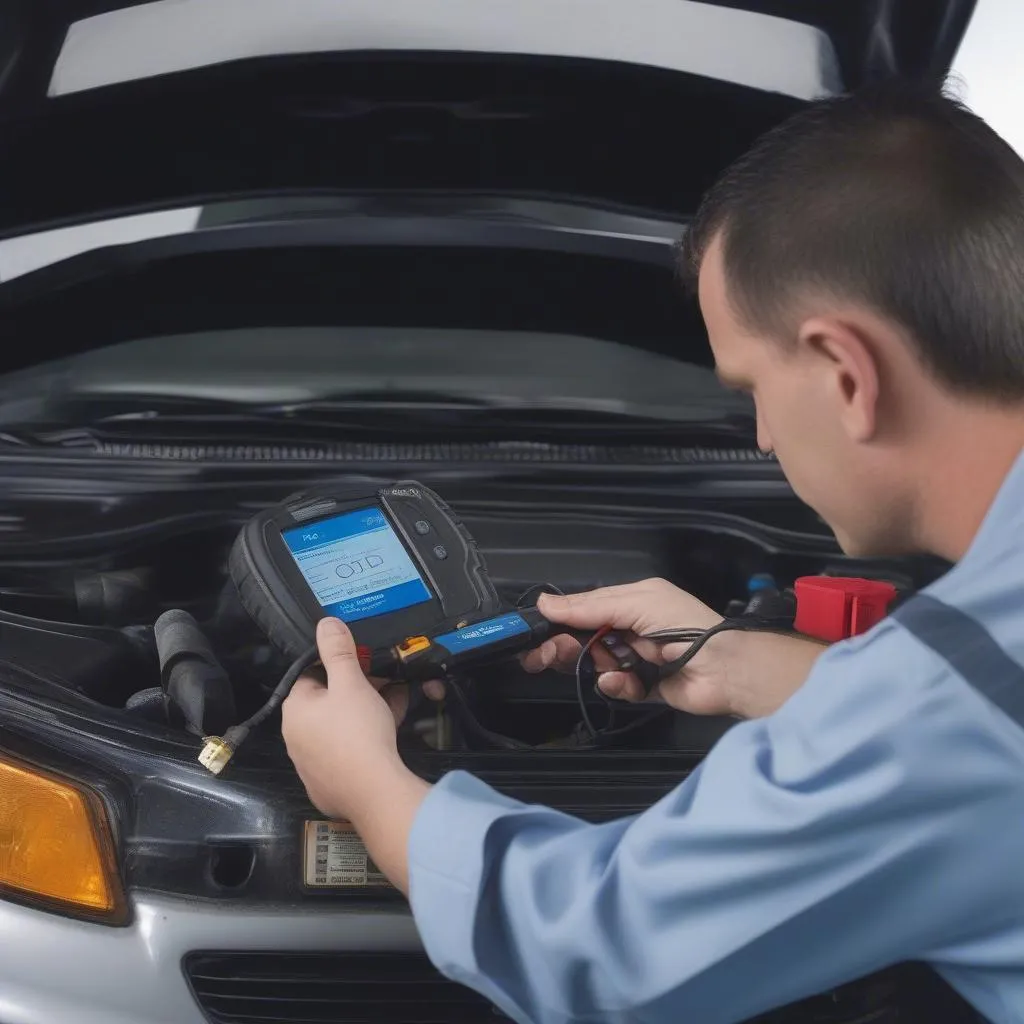Dealing with an AdBlue warning light or system message can be frustrating. Whether your car needs an AdBlue refill, you’ve had a recent repair, or you’re encountering a system glitch, knowing how to reset your AdBlue system can get you back on the road. This guide will walk you through the process of understanding, diagnosing, and resolving AdBlue issues, helping you steer clear of unexpected trips to the mechanic.
Understanding AdBlue Systems
Before diving into the reset process, it’s crucial to understand what AdBlue is and why it’s essential for your vehicle. AdBlue, also known as Diesel Exhaust Fluid (DEF), is a non-toxic solution injected into your diesel car’s exhaust system. Its primary function is to reduce harmful nitrogen oxide (NOx) emissions, converting them into harmless nitrogen and water vapor. This process not only benefits the environment but also ensures your vehicle complies with strict emissions standards.
 AdBlue system diagram
AdBlue system diagram
Recognizing AdBlue System Issues
Your vehicle will usually let you know when there’s a problem with the AdBlue system. Common indicators include:
- Warning messages: Your dashboard might display messages like “AdBlue System Fault,” “AdBlue Level Low,” or “Start Countdown in [Number] miles.”
- Warning lights: An illuminated AdBlue warning light (usually a pictogram of a refueling pump with a liquid droplet) signals a system malfunction.
- Limited engine performance (limp mode): In some vehicles, a serious AdBlue problem can trigger a limp mode, restricting your speed to prevent further damage to the emissions system.
Gathering the Necessary Tools
Before you attempt to reset your AdBlue system, having the right tools can make the process smoother and more efficient. Here’s what you might need:
- Diagnostic scanner: This tool allows you to read and clear fault codes from your vehicle’s Engine Control Unit (ECU), including those related to the AdBlue system.
- AdBlue reset tool: For certain vehicle models, a dedicated AdBlue reset tool might be necessary to perform a complete system reset.
- Protective gear: When handling AdBlue, it’s a good practice to wear gloves and safety glasses to prevent skin or eye irritation.
AdBlue Reset: Step-by-Step Guide
The process for resetting your AdBlue system can vary depending on your vehicle’s make, model, and the specific issue you’re facing. However, these general steps provide a good starting point:
- Address the underlying issue: Before attempting a reset, address the root cause triggering the AdBlue warning. This could involve refilling the AdBlue tank, repairing a faulty sensor, or replacing a malfunctioning AdBlue injector.
- Consult your owner’s manual: Your vehicle’s owner’s manual will have specific instructions on how to reset the AdBlue system for your particular model.
- Use a diagnostic scanner: Connect a diagnostic scanner to your vehicle’s OBD-II port and follow the on-screen instructions to read and clear any stored AdBlue-related fault codes.
- Utilize an AdBlue reset tool: If necessary, use a dedicated AdBlue reset tool to perform a more comprehensive system reset.
- Verify the reset: After completing the reset procedure, turn on your vehicle’s ignition (without starting the engine) and check if the AdBlue warning light has gone off. You can also use the diagnostic scanner to confirm that no fault codes are present.
 Mechanic diagnosing car with AdBlue issue
Mechanic diagnosing car with AdBlue issue
FAQs: Common AdBlue System Questions
- Can I drive with the AdBlue warning light on? It’s not recommended. Driving with an active AdBlue warning can lead to reduced engine performance and potential damage to your vehicle’s emissions system.
- What happens if I run out of AdBlue? Most vehicles will prevent the engine from starting once the AdBlue tank is completely empty. This is a safety measure to prevent damage to the emissions system.
- Can I reset the AdBlue system myself? Yes, depending on your vehicle model and the complexity of the issue, you may be able to reset the AdBlue system yourself using a diagnostic scanner or a dedicated reset tool.
For those seeking advanced diagnostics and troubleshooting for their vehicles, Cardiagtech offers a range of products designed to meet your needs.
Need Further Assistance?
While this guide offers general guidance, it’s essential to remember that AdBlue systems can be complex and vary significantly between vehicle makes and models. If you’re unsure about any aspect of the reset process or continue to experience issues, it’s always best to consult a qualified mechanic or reach out to CARDIAGTECH for expert assistance. We’re here to help you get back on the road safely and efficiently.

